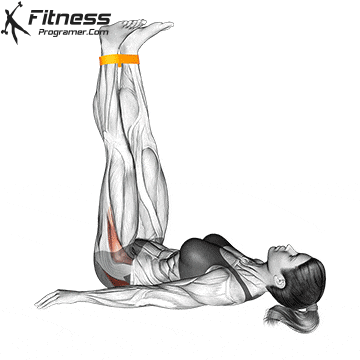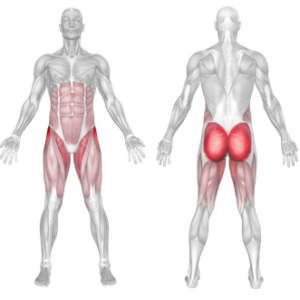Lying Banded Thigh Fly Overview
The banded thigh fly is a resistance exercise that involves lying on your back with a resistance band looped around your ankles or thighs. The movement requires you to open and close your legs while maintaining control against the band’s resistance.
How to Perform the Banded Thigh Fly

Lying Banded Thigh Fly (Floor Variation)
Starting Position:
- Lie on your back with your legs extended straight up toward the ceiling.
- Loop a resistance band around your ankles or just above your knees.
- Keep your lower back pressed against the floor and engage your core.
Movement:
- Slowly open your legs outward against the band’s resistance.
- Pause when you feel a deep stretch in your inner thighs.
- With control, bring your legs back together to the starting position.
- Repeat for 10 to 15 repetitions for three sets.
Tips for Proper Form
- Engage your core to keep your lower back stable.
- Move with control and avoid using momentum.
- Keep your knees slightly bent if you experience discomfort.
- Choose the right resistance level to challenge your muscles without compromising form.
- Breathe steadily, inhaling as you open your legs and exhaling as you bring them back together.
Common Mistakes to Avoid
- Arching the lower back: Keep your spine neutral to avoid strain.
- Using momentum: Perform the movement slowly to maximize muscle activation.
- Placing the band too low: Position it above the ankles or just above the knees for the best resistance.
- Holding your breath: Maintain steady breathing throughout the exercise.
Benefits of the Banded Thigh Fly
1. Strengthens the Glutes and Hip Stabilizers
Since the resistance band creates tension when the legs move outward, the gluteus medius and minimus play a primary role in controlling the motion. These muscles help stabilize the hips and improve lower-body strength.
2. Engages the Inner Thighs (Adductors) with Controlled Movement
Although the glutes are the primary muscles resisting the band’s tension, the inner thigh muscles (adductors) work during the return phase of the movement. They contract to bring the legs back together, promoting inner thigh strength and endurance.
3. Engages the Core for Stability
Keeping the legs elevated and controlling the movement requires core engagement, particularly in the abdominals and lower back. This enhances core stability, improving posture and reducing the risk of lower-back discomfort.
4. Supports Lower Body Balance and Coordination
By strengthening the gluteus medius and minimus, this exercise enhances pelvic stability, which is essential for maintaining balance. This benefit is especially useful for athletes and older adults looking to reduce the risk of falls.
5. Aids in Injury Prevention and Rehabilitation
Stronger hip stabilizers reduce the risk of knee and hip injuries by improving alignment and muscle control. This exercise is particularly helpful for individuals recovering from hip instability, groin strain, or glute weakness.
Banded Thigh Fly Muscles Worked

